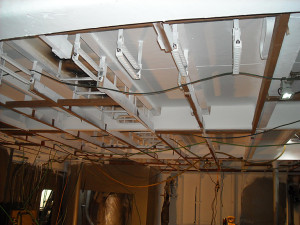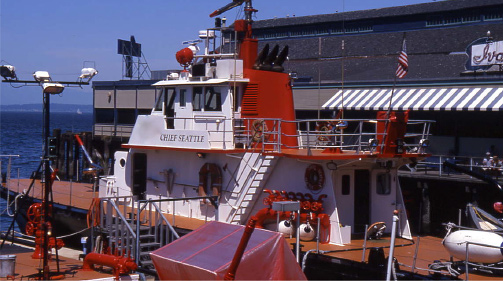Seattle Fire Department Fireboat Pilot House Refurbishing
Download PDF version of this case study 
Staying Warm and Dry on the Water.
Using LifeLast’s ThermaLast insulation coating to line the interior of the Chief Seattle fireboat wheelhouse for the City of Seattle’s Fire Department not only accomplished the primary goals of minimizing condensation and eliminating Corrosion Under Insulation (CUI), the fireboat crew also received cozier working conditions from the warmth ThermaLast provided.

The interior coating of the pilot house
The City of Seattle’s unique position as a metropolis abutting a saltwater body requires it possess emergency facilities accessible both from land and water. Special attention is required to maintain their fleet of fireboats because of the environmental conditions of the city’s typically cool, saline ambient air. Fireboats are not just for fire suppression, according to the SFD’s website, “the newest members of the fleet provide Emergency Medical Service, rescue and salvage in toxic environments, and have the ability to pump water for land-based firefighting if water mains break during earthquakes or other disasters.” The Chief Seattle fireboat, originally built in 1983, has undergone extensive retrofits to maintain its efficacy as well as extend the vessel’s service life another 20 years. Modernization efforts included increasing the engine size, upgrading the pumping capacity to over 10,000 gallons per minute, and refurbishing the pilot house.
The conventional insulation originally applied to the wheel-house was found ineffective in the marine vessel’s operating environment. Problems arose when the chilly climate of the Puget Sound collided with the warm interior temperatures of the vessel, causing condensation.
Conventional insulation proved ineffective when the warm air it contained met with cold atmospheric conditions, penetrating the pilot house’s steel framing. The results were massive amounts of condensation bleeding through to the interior of the vessel. Once the water droplets soaked the conventional insulation, its thermal conductivity quickly reduced to essentially zero.

The Chief Seattle’s wheelhouse condensation problem was resolved with ThermaLast
West Coast Marine Coatings brought LifeLast on hand to resolve the condensation-induced corrosion. ThermaLast was applied to the interior ceiling and walls of the wheelhouse. By applying the insulative coating directly to the substrate, convective heat loss within the insulation was eliminated. Unlike conventional insulation, ThermaLast blocks the thermal transfer that causes condensation normally where warm and cold surfaces meet. Just 40 mils of ThermaLast are enough to eliminate convective heat loss and block the thermal transfer at the steel substrate, eliminating the condensation.
The Chief Seattle was put back into commission in January of 2013 and will stay in service at least another two decades. It will remain the city’s largest freshwater fireboat in their fleet. The drier, warmer wheelhouse is a welcome upgrade to the crew stationed aboard the vessel.
Questions or technical assistance on your specification or project?
Contact us; we’re happy to help. Email us at info@LifeLast.com or call (512) 628.2112.




